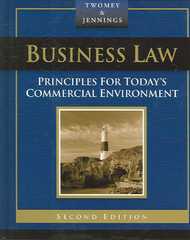Question
Consider H households, with household h consisting of Ih members. There is a single consumption good in this economy. Individuals also care about leisure, thus
Consider H households, with household h consisting of Ih members. There is a single consumption good in this economy. Individuals also care about leisure, thus their per-period utility is ui,h(ci,h, li,h), where i denotes the individual and h denotes the household. This utility function is differentiable in both arguments and satisfies all usual conditions. Individuals discount the future at rate and maximize expected utility. Assume that there exist a countable set of payoff relevant states of nature St in period t, and we denote a generic state by st (st St). As usual we denote a history by st = (s1, ..., st). The probability of history st is (st ). The sources of individual income are wage income and non labor income. Non-labor income in history st is yi,h (st) and the hourly wage rate as wi,h (st). Note that both income and wages only depend on the current state st. Thus, total wage income of individual i in household h and state st will be the wage rate wi,h (st) times the number of units of time worked. Each individual has a total time endowment of Ti,h per period. Finally, there is a transfer schedule amongst households. Let h (s) denote the (net) transfer received by household h when state s is realized We begin by assuming that the risk sharing unit is the household. Assume a unitarian household model in which allocations are decided as a result of an efficient social-planner-like decision rule with weights i,h on individual utility functions. (1) Write down the program that a household h solves when deciding consumption and labor allocations for its members. (2) Characterize the solution to the allocation problem. Please be explicit on which variables ci,h and l i,h depend. Provide a precise intuition why the solution depends on those variables (and why not on some others). (3) With your answer to the previous question in mind: what do you think of the usual risk sharing regressions? Why might a significant effect of individual income in the consumption regression not be informative about the absence of risk-sharing?
(4) Now suppose that consumption and leisure are separable in individuals' preferences. Formally, suppose that ui,h (c, l) = vi,h (c) + qi,h (l). Which variables determine individual leisure and consumption now? (5) How could this allocation be decentralized, (assuming that each agent is free to decide how much to work)? (6) Does individual labor supply of agent i in household h depend on wages and incomes of individuals in the household? Why or why not? (7) Suppose only for this question that the utility function was CARA only in consumption (i.e.,ui,h(c) = eihc) and you would like to identify the risk aversion of agents in a household. Could you identify the parameter ih using the usual risk-sharing regression? Why or why not? (8) Express the indirect utility function of household h, h, implicitly. What are the arguments of the indirect utility function?
We now assume that the village is the risk sharing unit. (9) Set up the planning problem for the village and prove that this problem can be solved by the determination of state contingent transfers ih to maximize the weighted sum of household indirect utilities. (10) Characterize the allocation. How would the allocation rule differ in two different states, and , that satisfy the following property H I H s s h=1 h i,h Ih i,h i=1 y (s) = h=1 i=1 y (s )? (11) What regression would you run to test for risk-sharing within the family and across families within the village?
Step by Step Solution
There are 3 Steps involved in it
Step: 1

Get Instant Access to Expert-Tailored Solutions
See step-by-step solutions with expert insights and AI powered tools for academic success
Step: 2

Step: 3

Ace Your Homework with AI
Get the answers you need in no time with our AI-driven, step-by-step assistance
Get Started


